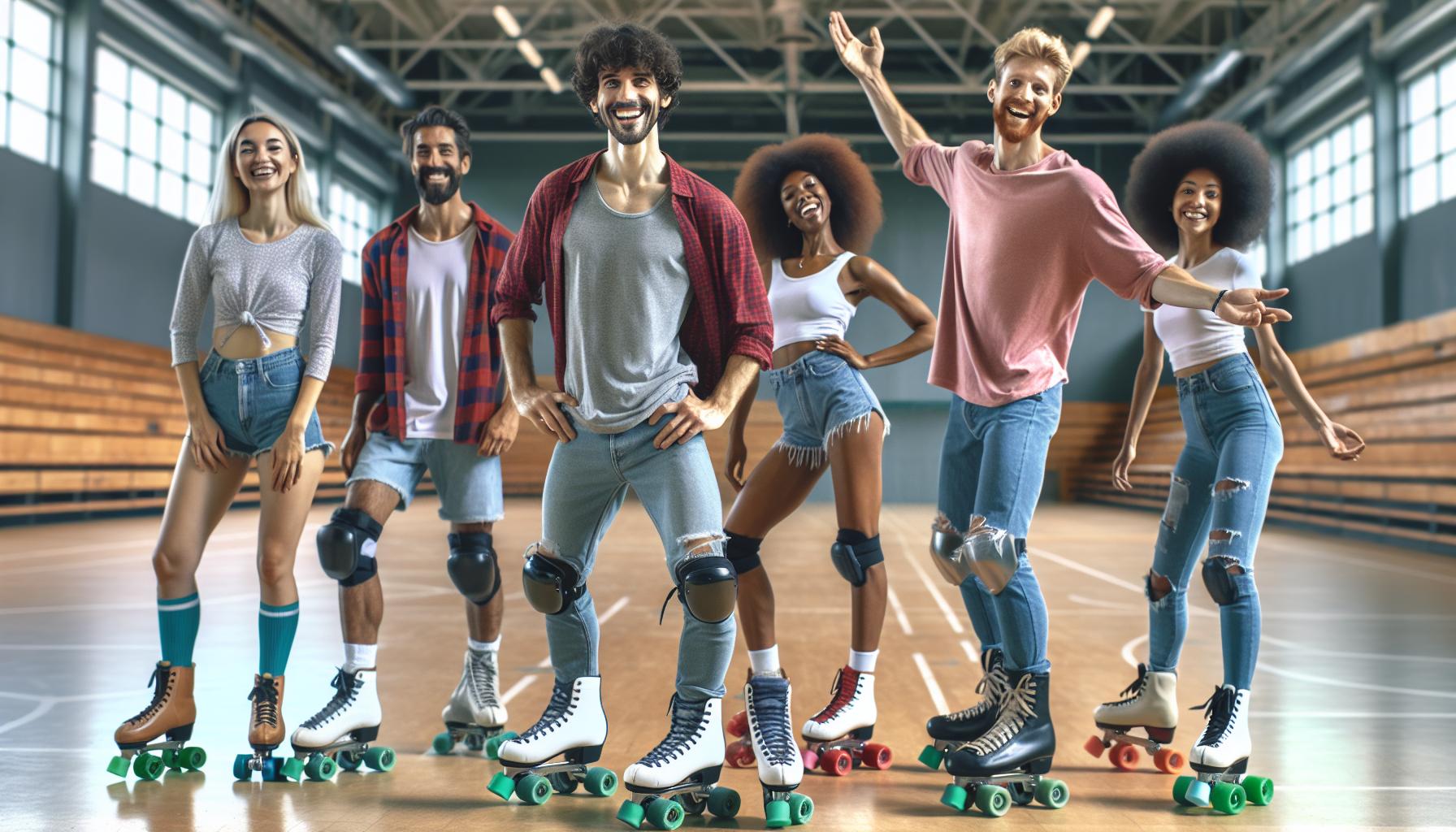Roller skating isn’t just for kids; it’s a fantastic way for adults to embrace fun and fitness. I remember the first time I laced up my skates as an adult. The excitement mixed with a hint of nervousness made me realize that it’s never too late to learn something new. Whether you’re looking to relive childhood memories or just want a unique workout, roller skating offers a perfect blend of joy and exercise.
As I dove into this vibrant world, I discovered that learning to roller skate as an adult comes with its own set of challenges and rewards. With the right mindset and a few tips, I found that anyone can glide smoothly across the rink. Join me as I share my journey and insights on how to conquer those initial wobbles and embrace the thrill of roller skating.
Key Takeaways
- Roller skating is not just for kids; it’s an engaging way for adults to improve fitness and mental well-being while having fun.
- Benefits include enhanced cardiovascular health, increased strength, better balance, and improved mood, making it an excellent full-body workout.
- Choosing the right equipment, including well-fitting skates and protective gear, is essential for a safe roller skating experience.
- Mastering basic techniques such as stopping, gliding, and maintaining proper posture is crucial for beginner skaters to build confidence.
- Overcoming fears and challenges associated with learning to skate can be facilitated through safe falling techniques and supportive environments.
- Joining local roller skating communities provides opportunities for social interaction, skill improvement, and participating in fun events.
Learning to Roller Skate As an Adult
Learning to roller skate as an adult provides numerous advantages, enhancing both physical and mental well-being. Engaging in this activity not only promotes fitness but also fosters a positive mindset.
Physical Health Advantages
Roller skating promotes cardiovascular health. It elevates heart rate, improving overall circulation. Skating strengthens muscles, particularly in the legs, core, and even the arms. I noticed better balance and coordination as I progressed. This activity also enhances flexibility, reducing the risk of injury. Engaging in roller skating burns approximately 600 calories per hour, making it an efficient exercise option. Consistent skating boosts endurance, leading to improved stamina and energy levels.
Mental Health Benefits
Roller skating offers significant mental health benefits. It reduces stress by releasing endorphins, which improve mood. I found that skating provides a sense of freedom and joy, helping to alleviate anxiety. Regular participation fosters social connections, as I sometimes skate with friends or join local clubs. This social aspect can enhance feelings of community and belonging. Additionally, learning a new skill like roller skating builds confidence, contributing to a more positive self-image.
Preparing to Start Roller Skating

Getting ready to roller skate as an adult involves selecting the right equipment and finding the ideal location. These steps help ensure a safe and enjoyable experience.
Choosing the Right Equipment
Selecting the right roller skates is crucial. Skate types include quad skates and inline skates. Quad skates, with their four wheels, offer more stability for beginners. Inline skates provide speed and agility but require additional balance.
Opt for skates that fit well without pinching or sliding. Consider features like adjustable sizes for growing feet or ankle support for added stability. Don’t forget protective gear, including helmets, wrist guards, knee pads, and elbow pads. These items minimize the risk of injury, especially during falls.
Finding a Suitable Location
Choosing the right place to skate enhances the experience. Look for smooth, flat surfaces like local parks, community rinks, or empty parking lots. These areas should be free from obstacles, potholes, or gravel, ensuring a safer ride.
Check local facilities or skate parks, which often host adult skating sessions. These venues provide a controlled environment, an opportunity to practice skills, and the chance to meet fellow skaters. Always be mindful of skating rules and etiquette, especially in public spaces, to ensure a positive experience for yourself and others.
Techniques for Beginners

Learning basic techniques is essential for mastering roller skating. I’ll outline crucial skills and safety practices that make the process smoother and more enjoyable.
Basic Skating Techniques
- Posture: Keep a slight bend in your knees while leaning slightly forward. Maintain an upright posture for better balance.
- Gliding: Begin with one foot in front of the other. Push with the back foot and glide on the front foot. Alternate feet for continuous movement.
- Stopping: Use the toe stop to come to a complete stop. Point your toes down to engage the brake. Practice this repeatedly to build confidence.
- Turning: Shift your weight onto the skater’s outside foot when turning. Use gentle movements to maintain control and avoid falling.
- Balance Exercises: Practice standing on one foot and gently lifting the other off the ground. This helps improve overall stability while skating.
- Wear Protective Gear: Always wear a helmet, knee pads, elbow pads, and wrist guards. This reduces injury risk during falls.
- Choose Safe Locations: Skate at smooth, flat venues like rinks or designated areas. Avoid uneven surfaces or crowded spaces to minimize hazards.
- Skate with Friends: Bring a buddy while skating, especially during initial attempts. This adds support and enhances the experience.
- Practice Falling: Learn how to fall safely by bending your knees and rolling onto your side. This technique minimizes the impact on joints.
- Stay Aware of Surroundings: Keep an eye out for other skaters or obstacles nearby. This enhances reaction time during movement.
Overcoming Common Challenges

Learning to roller skate as an adult presents some common challenges. By addressing these hurdles, I improved my skills and enjoyed the process more.
Fear of Falling
Fear of falling often inhibits progress. To tackle this fear, I practiced falling safely. I learned to bend my knees and roll to the side, which minimized impact. Choosing a padded environment, like a soft surface or a gym floor, helped ease my anxiety. Gradually, as I became more comfortable, I focused on riding with friends or in an adult skating class. Being surrounded by supportive individuals made the process less intimidating. Small setbacks became learning experiences rather than failures.
Building Confidence
Building confidence is crucial for improvement. I started with basic skills, allowing myself to master each before advancing. Consistent practice led to noticeable progress. Setting manageable goals, like skating a few laps without falling, helped reinforce my success. Positive self-talk became essential; I reminded myself that everyone started somewhere. Additionally, celebrating milestones, no matter how small, accelerated my confidence. Sharing my journey with others created a supportive network, which strengthened my commitment to roller skating.
Joining Roller Skating Communities
Joining roller skating communities enhances the experience and provides opportunities for social interaction. Many resources exist for adults seeking to connect with fellow skaters.
Finding Local Groups
Finding local groups simplifies the learning process. Community resources such as Meetup, Facebook groups, and skating associations provide opportunities to connect with other skaters. Local skate shops often host gatherings and can connect newcomers with experienced skaters. Additionally, many cities have roller derby teams that welcome recreational skaters. Participating in these groups offers tips, motivation, and camaraderie.
Participating in Events
Participating in roller skating events invigorates the skating journey. Local rinks schedule themed skate nights, races, and workshops for all skill levels. These events foster a sense of community while providing structured learning environments. Many cities host annual roller skating festivals featuring music, food, and exhibitions. Engaging in these activities enhances skills and helps form long-lasting friendships with fellow skating enthusiasts.



